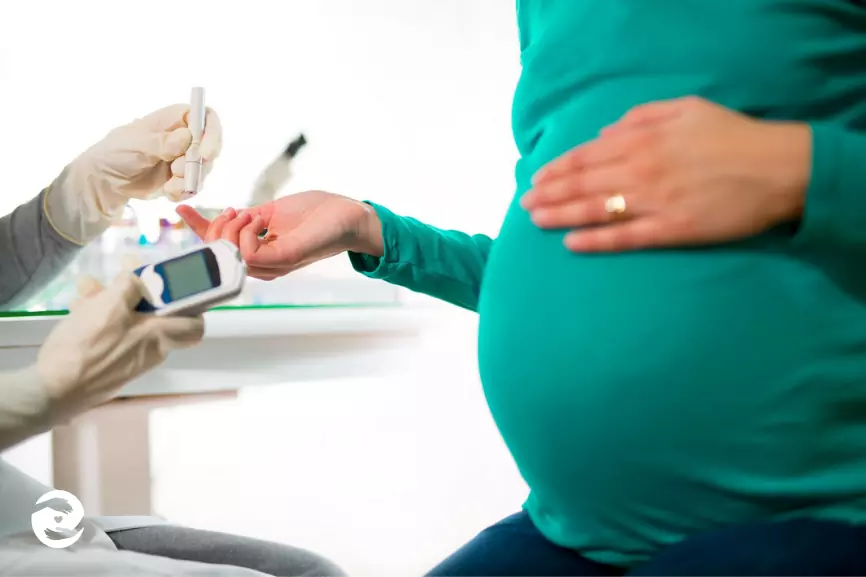The Facts About Gestational Diabetes

What is Gestational Diabetes:
Gestational diabetes is high blood sugar (glucose) that develops during pregnancy and usually disappears after giving birth.
It can happen at any stage of pregnancy but is more common in the second or third trimester.
It happens when your body cannot produce enough insulin – a hormone that helps control blood sugar levels – to meet your extra needs in pregnancy.
Gestational diabetes can cause problems for you and your baby during pregnancy and after birth. But the risks can be reduced if the condition is detected early and well managed.
Who’s at risk of gestational diabetes?
Any woman can develop gestational diabetes during pregnancy, but you’re at an increased risk if:
- your body mass index (BMI) is above 30
- you previously had a baby who weighed 4.5kg (10lb) or more at birth
- you had gestational diabetes in a previous pregnancy
- 1 of your parents or siblings has diabetes
- You are of South Asian, Black, African-Caribbean or Middle Eastern origin (even if you were born in another country)
If any of these apply to you, you should be offered screening for gestational diabetes during your pregnancy.
Symptoms of gestational diabetes
Gestational diabetes does not usually cause any symptoms.
Most cases are only discovered when your blood sugar levels are tested during screening for gestational diabetes.
Some women may develop symptoms if their blood sugar levels get too high (hyperglycaemia), such as:
- increased thirst
- needing to pee more often than usual
- a dry mouth
- tiredness
But some of these symptoms are common during pregnancy and are not necessarily a sign of gestational diabetes. Speak to your midwife or doctor if you’re worried about any symptoms you’re experiencing.
How gestational diabetes can affect your pregnancy
Most women with gestational diabetes have otherwise normal pregnancies with healthy babies.
However, gestational diabetes can cause problems such as:
- your baby growing larger than usual – this may lead to difficulties during the delivery and increases the likelihood of needing induced labour or a caesarean section
- polyhydramnios – too much amniotic fluid (the fluid that surrounds the baby) in the womb, which can cause premature labour or problems at delivery
- Premature birth – giving birth before the 37th week of pregnancy
- Pre-eclampsia – a condition that causes high blood pressure during pregnancy and can lead to pregnancy complications if not treated
- your baby developing low blood sugar or yellowing of the skin and eyes also known as jaundice after he or she is born, which may require treatment in hospital
- the loss of your baby (stillbirth) – though this is rare
Having gestational diabetes also means you’re at an increased risk of developing type 2 diabetes in the future.
Screening for gestational diabetes
During your first antenatal appointment (also called a booking appointment) at around week 8 to 12 of your pregnancy, your midwife or doctor will ask you some questions to determine whether you’re at an increased risk of gestational diabetes.
If you have 1 or more risk factors for gestational diabetes you should be offered a screening test.
The screening test is called an oral glucose tolerance test (OGTT), which takes about 2 hours.
It involves having a blood test in the morning when you have not had any food or drink for 8 to 10 hours (though you can usually drink water but check with the hospital if you’re unsure). You’re then given a glucose drink.
After resting for 2 hours, another blood sample is taken to see how your body is dealing with the glucose.
This may differ depending on the hospital you attend where they may simply take a blood test called an HBA1C and that will give a reading and decide if you have gestational diabetes without having to do the GTT test.
The OGTT is done when you’re between 24 and 28 weeks pregnant. If you’ve had gestational diabetes before, you’ll be offered an OGTT earlier in your pregnancy, soon after your booking appointment, then another OGTT at 24 to 28 weeks if the first test is normal.
Treatments for gestational diabetes
If you have gestational diabetes, the chances of having problems with your pregnancy can be reduced by controlling your blood sugar levels.
You’ll be given a blood sugar testing kit so you can monitor the effects of treatment.
Blood sugar levels may be reduced by changing your diet and exercise routine. However, if these changes don’t lower your blood sugar levels enough, you will need to take medicine as well. This may be tablets or insulin injections.
You’ll also be more closely monitored during your pregnancy and birth to check for any potential problems.
If you have gestational diabetes, it’s best to give birth before 41 weeks. Induction of labour or a caesarean section may be recommended if labour does not start naturally by this time.
Earlier delivery may be recommended if there are concerns about your or your baby’s health or if your blood sugar levels have not been well controlled.
Long-term effects of gestational diabetes
Gestational diabetes normally goes away after birth. But women who’ve had it are more likely to develop:
- gestational diabetes again in a future pregnancy
- type 2 – a lifelong type of diabetes
You should have a blood test to check for diabetes 6 to 13 weeks after giving birth, and once every year after that if the result is normal.
See your GP if you develop symptoms of high blood sugar, such as increased thirst, needing to pee more often than usual, and a dry mouth – do not wait until your next test.
You should have the tests even if you feel well, as many people with diabetes do not have any symptoms.
You’ll also be advised about things you can do to reduce your risk of getting diabetes, such as maintaining a healthy weight, eating a balanced diet and exercising regularly.
Some research has suggested that babies of mothers who had gestational diabetes may be more likely to develop diabetes or become obese later in life.
Breastfeeding if you have gestational diabetes
Having gestational diabetes should not stop you from breastfeeding your baby.
If your diabetes is well controlled, your breast milk will be the same as breast milk from a woman without diabetes.
Babies born to mothers with gestational diabetes are at risk of hypoglycaemia (low blood sugar levels) and so it is recommended that babies have their blood sugar levels checked following birth in addition to the usual newborn checks.
Newborn babies of diabetic mothers when there has been poor diabetic control in pregnancy will often struggle with their blood sugar levels after birth. This is due to the baby overproducing their insulin whilst growing in the uterus to help process the excess sugars passed from the mother’s bloodstream.
These babies may have high insulin levels persisting in the first few days after birth which can result in hypoglycaemia as they are no longer receiving excess sugar from the mother’s bloodstream and they may struggle to regulate their insulin production to normal levels.
Babies of mothers who have had reasonably good blood glucose control may still suffer from low blood sugar levels after birth too and so it is recommended that all babies born to diabetic mothers (including gestational diabetes) have their blood sugar levels checked.
In most hospitals, newborns born to diabetic mothers are routinely monitored for hypoglycaemia.
Each hospital is different as to how they monitor blood sugar levels, but the procedure is the same.
A midwife or nurse will heel prick the baby to obtain enough blood to be tested on a blood glucose test monitor, the same as we use to monitor our blood sugar levels throughout the pregnancy.
The policy in each hospital is different but generally, the babies blood sugars are checked pre feeds and we are looking for levels of anything above 2.8mmol/l for the first pre-feed sugars and if they are ok pre the 2nd and 3rd feed then we don’t check anymore until the baby is 48 hours old where the level should be 3.3mmol/l and above. Again, every hospital is different so you may need to check this depending on where you are having your baby.
Prevention of Hypoglycemia
- Keep blood sugar levels within target and stabilised – It is best to try to keep your blood sugar levels within your targets and stabilised throughout your pregnancy, avoiding high spikes in levels, especially leading up to and during labour. Some mothers will be on a sliding scale insulin & glucose drip to control blood sugar levels during labour, but this may not be necessary if you gain good control over your levels.
- Skin to skin and 1st feed – Once a baby is born, skin to skin is very important and initiating a first breastfeed within the first 30 mins will aid good blood sugar levels in the baby.
- Colostrum harvesting – Many mothers with gestational diabetes harvest colostrum before the birth of a baby to be able to give the newborn top up feeds, should breastfeeding be a problem, or to give additional top-up feeds in between feeds as colostrum is the best thing to raise blood sugar levels.


